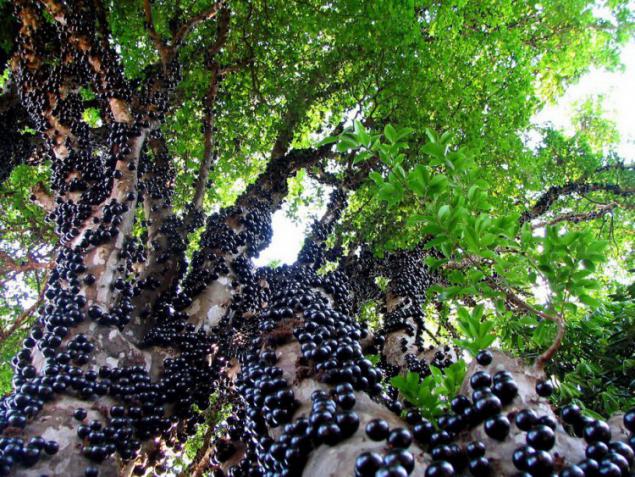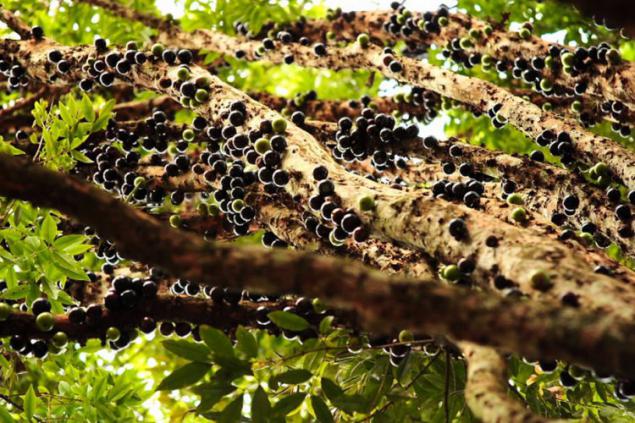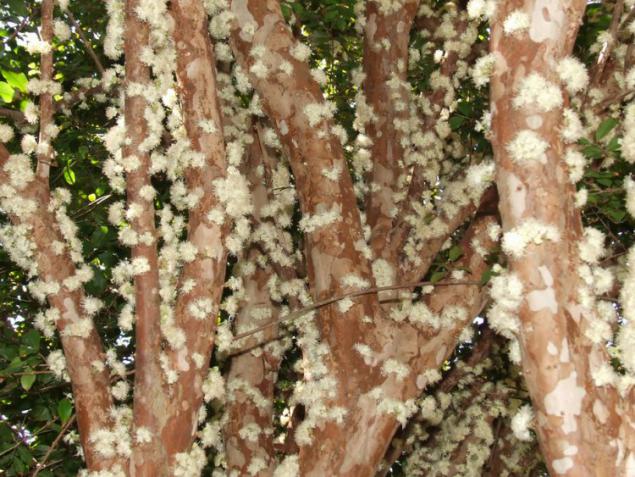1077
Unusual tree
Dzhabotikaba (lat. Myrciaria caulifloria, port. Jaboticaba, English. Brazilian Grape Tree (Rus. Brazilian grape tree) - the plant family Myrtaceae, native to tropical latitudes, and cultivated it as a fruit crop. The fruits of this tree grow directly on the trunk and main branches, which gives it such an unusual appearance.

Dzhabotikaba - slow growing evergreen tree height from 5 to 12 meters with oval-lanceolate glossy leathery leaves 2, 5-10 cm long and 1 cm wide, 25-2. Flowers are white with 4 petals and stamens 60 to 4 mm each. Fruit - round or elliptical, glossy maroon-purple, almost black, with the remnants of a drupe sepals at the end and with white or pink translucent jelly-like juicy flesh with a diameter 0, 6-4 cm.

The fruits grow in clusters on the trunks and main branches. This phenomenon is called cauliflory - the formation of the fruit on the trunk and main branches.

Dzhabotikaba found in the wild, and the crop in South Brazil, Bolivia, Paraguay and northern Argentina. At present, naturalized and cultivated in Uruguay, Colombia, Panama, Peru, Cuba and the Philippines.

The fruit pulp is edible dzhabotikaby fresh. Among them are made of jelly, jellies, juices and alcoholic beverages. A decoction of dried fruit peels dzhabotikaby in Brazil is used as a remedy for asthma, diarrhea and dysentery.

In Brazil, from dzhabotikaby make excellent red wine. Peel the fruit is slightly bitter because of the high content of tannin. It is used for coloring in the deep red color of jams, jellies and wines.

Dzhabotikaba commercially grown only in Brazil and in some countries of South America. The slow growth of the tree, sensitivity to frost and short term storage of fruits prevents commercial use.

During the fruiting season dzhabotikaby across town located street vendors with bags, brim full of juicy black berries.




Dzhabotikaba - slow growing evergreen tree height from 5 to 12 meters with oval-lanceolate glossy leathery leaves 2, 5-10 cm long and 1 cm wide, 25-2. Flowers are white with 4 petals and stamens 60 to 4 mm each. Fruit - round or elliptical, glossy maroon-purple, almost black, with the remnants of a drupe sepals at the end and with white or pink translucent jelly-like juicy flesh with a diameter 0, 6-4 cm.

The fruits grow in clusters on the trunks and main branches. This phenomenon is called cauliflory - the formation of the fruit on the trunk and main branches.

Dzhabotikaba found in the wild, and the crop in South Brazil, Bolivia, Paraguay and northern Argentina. At present, naturalized and cultivated in Uruguay, Colombia, Panama, Peru, Cuba and the Philippines.

The fruit pulp is edible dzhabotikaby fresh. Among them are made of jelly, jellies, juices and alcoholic beverages. A decoction of dried fruit peels dzhabotikaby in Brazil is used as a remedy for asthma, diarrhea and dysentery.

In Brazil, from dzhabotikaby make excellent red wine. Peel the fruit is slightly bitter because of the high content of tannin. It is used for coloring in the deep red color of jams, jellies and wines.

Dzhabotikaba commercially grown only in Brazil and in some countries of South America. The slow growth of the tree, sensitivity to frost and short term storage of fruits prevents commercial use.

During the fruiting season dzhabotikaby across town located street vendors with bags, brim full of juicy black berries.



Interesting facts about the film "Some Like It Hot"
10 seats to the "dark history" or eerie atmosphere
























